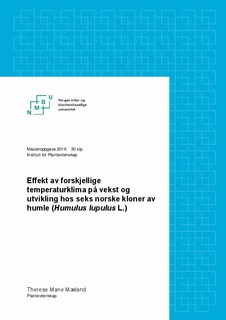Effekt av forskjellige temperaturklima på vekst og utvikling hos seks norske kloner av humle (Humulus lupulus L.)
Master thesis
Permanent lenke
http://hdl.handle.net/11250/2398742Utgivelsesdato
2016-08-11Metadata
Vis full innførselSamlinger
- Master's theses (IPV) [240]
Sammendrag
Humle (Humulus lupulus L) har lang tradisjon som kulturplante i Norge, men kunnskapen om
dyrking av planten er i stor grad borte her i landet. De siste årene har mikrobryggerinæringen
vært interessert i lokale råvarer til øl, og har etterspurt norsk humle. For å vurdere
mulighetene for produksjon, må dyrkingsegenskapene til det norske materialet undersøkes.
Denne oppgaven undersøkte effekten av forskjellige temperaturklima på vekst og utvikling
hos seks norske kloner av humle. Ulike dyrkingssystem, friland, tunell og plasthus, ble
benyttet for å få frem forskjellige temperaturklima. Plantene ble etablert fra rotstokkmasse
samme året som forsøket ble gjennomført, og dyrket frem i potter.
Det ble oppnådd størst forskjell i temperatur mellom plasthus og de andre to
dyrkingssystemene. I plasthus var dyrkingstemperauren i gjennomsnitt var 19,0 °C, i tunell
14,6 °C i tunell og 14,0 °C på friland. Værforholdene sommeren 2015 var av betydning for
temperaturforskjellene som ble oppnådd.
Både morfologisk og generativ utvikling gikk raskere under temperaturklimaet i plasthus. For
alle kloner var fenologisk utviklingshastighet i gjennomsnitt to uker raskere her,
sammenlignet med friland og tunell. Mellom dyrkingssystemene var lengde av sideskudd og
antall nodier ved blomstring signifikant høyest i plasthus, og dette la grunnlaget for at også
avlingene ble signifikant høyere her. Lengden av sideskudd økte signifikant fra tunell til
friland, men avlingen var signifikant lik under disse temperaturklimaene.
Klon 6, 7, 37 og 40 hadde signifikant økning i avling i plasthus, samtidig som klon 6 og klon
40 også utviklet signifikant lengre sideskudd her. Temperaturøkningen i plasthus hadde ikke
signifikant betydning for avling og lengde av sideskudd for klon 1 og klon 19.
Klon 40 markerte seg som mest interessant for produksjon. Under alle temperaturklima
utviklet den i gjennomsnitt lengst sideskudd. Høyt antall nodier ved blomstring og sen
fenologisk utviklingshastighet dannet grunnlaget for den høyeste gjennomsnittsavlingen
totalt. Klon 6, 7 og 37 tydet også på å være interessante for produksjon, mens klon 1 og klon
19 kom dårligst ut i dette forsøket. Hops (Humulus lupulus L.) has formerly been cultivated in Norway, however, much of the
knowledge as to cultivating the plant has been lost over time. Over the past few years, there
has been an increased interest amongst microbreweries to use local ingredients for brewing
beer, and a request for knowledge on Norwegian hops. To consider the possibilities for
production, it is necessary to investigate the cultivation characteristics of the Norwegian
clones.
This research has investigated the effect of three different temperature climates with regards
to growth and development of six clones of Norwegian hop. Three different production
systems were used to achieve different temperature climates, which included field, an open
tunnel and a closed tunnel. The plants were established from rootstocks the same year as the
trials were conducted, and the plants were grown in pots.
The largest difference in temperature was between the closed tunnel and the other two
production systems. The temperatures were on average 19,0 °C in the closed tunnel, 14,6 °C
in the open tunnel and 14,0 °C in the open field. The weather throughout the season
influenced the variation in the recorded temperatures.
Both morphological and generative development increased in rate under the temperature
climate in the closed tunnel. Phenological development increased with a minimum of two
weeks in the closed tunnel for all clones. Between the production systems, the length of the
lateral shoots and number of nodes at flowering was significantly higher in the closed tunnel,
and this was probably the main reason for the significantly higher yield here. The length of
the lateral shoots increased significantly from the open tunnel compared to that in the field,
but there was no significant difference in the yield observed amongst them.
Clone 6, 7, 37 and 40 had a significant increase in yield when grown in the closed tunnel, and
clone 6 and clone 40 also developed significantly longer lateral shoots in the closed tunnel.
The increase in temperature in the closed tunnel did not have a significant effect on the yield,
nor length of lateral shoots for clone 1 and clone 19.
Clone 40 had outstanding results and was evaluated as the most interesting clone for use in
production. In all production systems, it developed on average the longest lateral length.
Clone 40 also had a high number of nodes at flowering, as well as a slow phenological
development rate, which provided a good basis for the high yield. Clones 6, 7 and 37 also showed to have potential for production, whereas clones 1 and clone 19 showed less potential
in this research.
